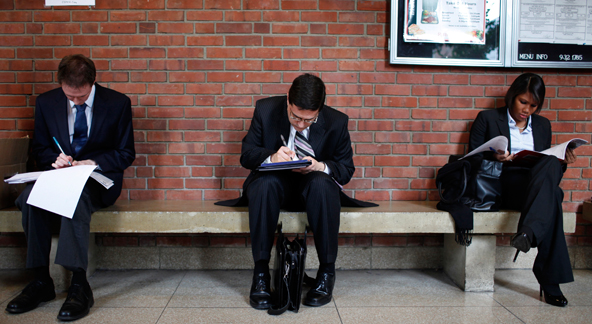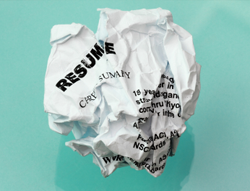Under the Gun: Avoiding Joining the Ranks of the Chronically Unemployed
15 February 2012

Not too long ago, unemployment was a temporary inconvenience – a short-to-medium-term waystation between career adventures. When times were good, you could even congratulate people on their recent layoff. You had every reason to suspect that the next opportunity would be even better.
Those days, alas, are over. Job hunting is looking less and less like a challenging sprint – stressful, but over quickly, and more and more like a grueling marathon. If you’ve been looking for a while, you understand the challenge you face. If you’re newly unemployed, Derek Thompson of The Atlantic has some depressing stats:
• The number of workers who have been unemployed for six months or longer has quadrupled since 2008.
• 5.5 million people have been out of work for six months or longer.
• 42 percent of unemployed workers over 55 have been out of work for 6 months or more.
• Those with 4-year degrees who are unemployed are not significantly less likely to be unemployed for more than six months than those with high school educations and even those who have not even graduated high school.
• The total number of jobs is less than it was in January of 2008 by about six million. That’s an even greater fall than the number of chronically unemployed.
Looked at another way – the percentage of chronically unemployed is at its highest level since the Great Depression.
Look Beyond the Unemployment Rate
Even so, the latest figures – published the first week of February by the Bureau of Labor Statistics, are showing a broadly brightening unemployment picture, by a variety of measures. The economy added over 240,000 jobs, and the unemployment rate fell to 8.3 percent.
Conservatives, however, point out that some of these jobs – the ones owing to more egregious “stimulus-funded” projects, are not sustainable. They also point out a drop in the labor force participation rate: They don’t count you as unemployed if you’ve given up the hunt for work entirely. Indeed, as of January 2012, the labor force participation rate stood at 63.7 percent: The first time in recent memory it has fallen below 64 percent.
In point of fact, even though the most frequently-cited unemployment figure has fallen, the percentage of employed compared to the total population has not risen. The difference reflects the number of discouraged workers – those whose unemployment benefits have run out, or those who have given up the search for full-time employment. Some of these people are doing the “couch tour.” Others are being supported by girlfriends, boyfriends, wives or husbands (or may have made a voluntary and rational choice to become a homemaker – and there’s some grey area between those two groups), or are eking out a subsistence income from odd jobs and various kinds of self-employment and cottage industries – the 21st century version of our grandparents “taking in laundry.”
When you adjust for the collapse in the labor force participation rate, the true jobless percentage exceeds 11.4 percent – with the percentage of underemployment going much higher.
The Disability Factor
One possible factor: As many as 25 percent of those outside of the labor force between ages 25 and 64 are collecting SSI or SSDI disability payments from the Social Security Administration. The total number of recipients now exceeds 8.5 million workers – and the percentage has increased from 4.5 percent pre-recession to 5.3 percent today. That’s an increase of over 15 percent – A curious development, as the editors of SoberLook.com point out, considering the fact that a collapse in manufacturing and construction employment should have significantly reduced the number of workplace-related disabilities. We don’t think they’re all getting carpal tunnel syndrome from typing.
The tragedy: When things turn around, it’s going to be very difficult for this group of people to re-enter the work force – especially at the wage levels they were earning before.
So What Now?
So what does this mean for the currently unemployed? Here are the takeaways:
1. Times are still tough. You don’t have time to put off a job hunt.
2. The time to find a job is within weeks of losing your last one. The data show that once you have been unemployed for six months, you are much more likely to stay unemployed.
3. Stay in the game. Even if you have to take part-time employment for a while, you can avoid having a gap on your resume. And your skills don’t get a chance to atrophy.
4. Even if you’re still working, you need to build a network of friends, colleagues and associates that will be in place to help you land employment quickly if you lose your job.
5. Savings is important. If you need to relocate for a job, you need to have cash on hand to seize the opportunity. There are plenty of applicants now for any opening, so companies don’t need to pay for relocation, anymore. But you are under the six-month gun, statistically. If you turn down a job that would require relocation, and nothing local opens up in six months or so, you have an uphill fight.
Finding work is a challenge for many people –even when times are good. In today’s market, it is an even more difficult, stressful, and emotionally draining process. A good employment agency – ideally specializing in your industry, is an important potential ally. In a pinch, a good agency can help supplement your personal network – and give you options, at a time when you need them most. You can’t build a network from scratch very fast while you’re busy raising a family and working a full-time job. Employment agency professionals build networks for a living – except what you call “contacts and connections,” employment agencies and headhunters call “clients.”
Find a CAREER with one of our “contacts and connections”,
we’ve got the best ones :)!




